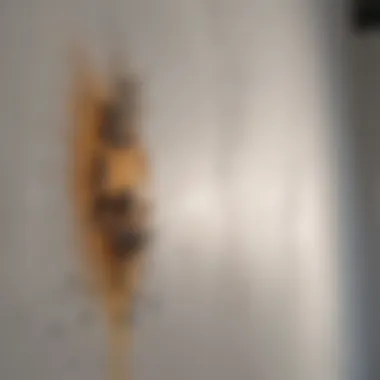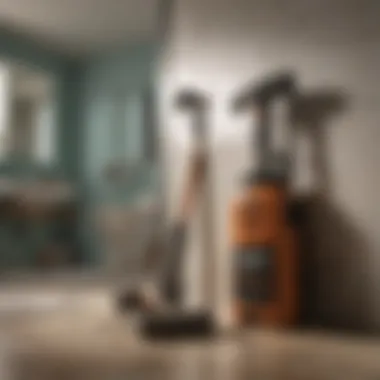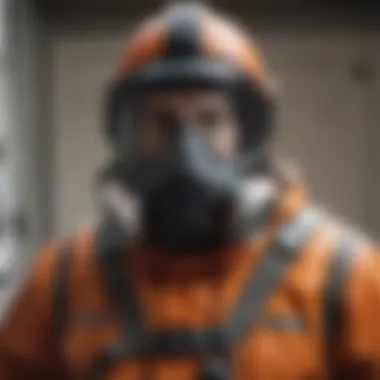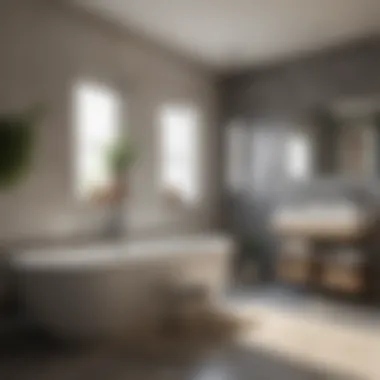Eliminating Mold from Bathroom Drywall: Comprehensive Guide


Intro
Mold growth in bathrooms is a common yet serious issue that many homeowners and renters face. The excessive moisture and humidity in these spaces create an ideal environment for mold spores to thrive. If left unaddressed, mold can lead to significant health risks and damage to drywall and other fixtures. This guide aims to provide an in-depth approach to eliminating mold from bathroom drywall, discussing its causes, prevention methods, and effective removal techniques. By following the advice given here, you can create a healthier living environment and maintain the integrity of your home.
Understanding Mold Growth
Causes of Mold in Bathrooms
Several factors contribute to mold growth in bathroom spaces. These include:
- High humidity: Bathrooms often lack adequate ventilation, allowing moisture to linger.
- Leaking pipes: Minor leaks can gradually increase moisture levels and create spots for mold to develop.
- Inadequate insulation: Poorly insulated walls can make the drywall cool, creating condensation that encourages mold growth.
- Dirty surfaces: Soap scum, hair, and organic materials can also serve as food sources for mold spores.
By recognizing these causes, homeowners can better understand how to tackle the problem effectively.
Preventive Measures
To prevent mold from appearing, consider the following strategies:
- Improve ventilation: Install exhaust fans or open windows while showering to reduce humidity.
- Maintain cleanliness: Regularly clean the bathroom surfaces to remove potential food sources for mold.
- Check for leaks: Conduct routine inspections of plumbing fixtures to catch leaks early.
- Seal surfaces: Apply a mold-resistant paint or sealant to bathroom walls and ceilings to create a barrier against moisture.
"Prevention is always better than cure. The best approach to mold in bathrooms is to not let it start at all."
Tools and Materials for Removal
Essential Tools
Before starting the mold removal process, gather the necessary tools. These may include:
- Safety goggles
- N95 respirator mask
- Long rubber gloves
- Sponge and scrub brushes
- Spray bottles
- Ladder (if needed)
Cleaning Solutions
Several effective cleaning solutions can be utilized to remove mold:
- Commercial mold removers
- A mixture of water and white vinegar
- A solution of water, baking soda, and dish soap
- Bleach solution (1 cup of bleach to 1 gallon of water)
Select the solution based on the severity of the mold growth and the type of surface being cleaned.
Steps for Mold Removal
Preparation
Start by ensuring the bathroom is well-ventilated. Open windows and doors, and turn on the exhaust fan. Wear all safety equipment before proceeding.
Application
- Identify mold-infested areas: Look for visible mold spots on the drywall.
- Apply cleaning solution: Choose one of the cleaning solutions and spray it directly onto the affected area.
- Scrub the mold: Using a sponge or scrub brush, gently scrub the area until the mold is removed.
- Rinse and dry: Wipe down the cleaned area with a damp cloth, followed by drying it thoroughly with a towel.
- Dispose of contaminated materials: Place any sponges or cleaning materials that have mold on them in a sealed bag before disposing of them.
Repairing Damaged Drywall
If mold has penetrated deep into the drywall, repairs may be necessary. This might involve cutting out and replacing the affected sections. Always ensure that the area is dry before making repairs.
End
Mold on bathroom drywall is not just an aesthetic issue; it poses health risks and can lead to structural damage. Addressing the underlying causes of mold growth, implementing preventive measures, and following systematic removal steps are vital in maintaining a clean and healthy bathroom space. By investing time in these practices, you create a more enjoyable and safer home environment.
Understanding Mold Growth
Understanding how mold grows is crucial for effectively addressing the problem in your bathroom. Mold can lead to significant health issues and structural damage if not controlled. It is essential to grasp what mold is, how it forms on drywall, and the conditions that promote its growth. This section will help homeowners and renters recognize the nuances of mold proliferation and equip them with knowledge to combat it effectively.
What Is Mold?
Mold is a type of fungus that exists in various forms, including mildew and yeast. It thrives in damp environments and reproduces through spores, which are invisible to the naked eye. These spores can travel through the air and settle on various surfaces. When they find the right conditions, such as moisture, they can grow and multiply quickly.


In a home setting, mold can appear in various colors, including black, green, and white. It often forms in patches, creating an unsightly appearance on surfaces. Besides aesthetics, some mold varieties can produce allergens and toxins that may exacerbate allergies or trigger respiratory issues. Thus, recognizing and addressing mold growth shouldn't be taken lightly.
How Mold Forms on Drywall
Drywall is a popular construction material, highly valued for its affordability and ease of installation. However, it is not impervious to mold growth. Mold forms on drywall when moisture is present for extended periods. This moisture can come from a variety of sources: leaks in plumbing, high humidity levels, or inadequate ventilation. Once the drywall becomes wet, the paper backing offers an ideal surface for mold to cling to, using it as a food source.
When mold spores settle on damp drywall, they can adhere and begin to grow within 24 to 48 hours. Therefore, it is critical to act swiftly if moisture is detected. Regular inspections of your bathroom can help identify water issues before they become severe. Addressing leaks and improving waterproofing in areas like bathrooms is vital to prevent mold growth.
Conditions Favoring Mold in Bathrooms
Bathrooms are often prime locations for mold growth due to their inherent moisture. Consider the following factors that contribute to mold development in these spaces:
- Humidity: High humidity levels, particularly without proper ventilation, create an ideal environment for mold. Showers and baths contribute significantly to bathroom humidity.
- Poor Ventilation: Many bathrooms lack adequate ventilation, allowing moisture-laden air to linger. Exhaust fans can help mitigate this risk by expelling moist air.
- Moisture Sources: Water leaks from fixtures, plumbing, or condensation can continuously saturate surfaces, providing perfect conditions for mold.
- Temperature: Mold thrives in warm conditions. Bathrooms often maintain higher temperatures due to heated water, increasing the likelihood of mold growth.
Homeowners should focus on controlling these conditions to effectively combat mold. Implementing proactive measures, such as improving airflow, fixing leaks promptly, and using dehumidifiers, can significantly reduce the risk.
Identifying Mold in Your Bathroom
Identifying mold is a crucial step in the process of eliminating it from your bathroom drywall. Mold can be harmful, both structurally and health-wise. Often, homeowners may miss early signs. Recognizing these signs can lead to prompt action, minimizing further damage and health risks. Moreover, understanding both visual and olfactory indicators will assist in a more thorough inspection.
Visual Signs of Mold
Visual indicators are often the first method of detection. Look for signs such as:
- Discoloration: Mold often appears as black, green, or brown spots on the surface. Pay close attention to corners, ceilings, and walls, especially if they have been exposed to moisture.
- Texture Changes: Mold can cause a change in texture. See if surfaces feel slick or have a fuzzy appearance.
- Water Damage: Stains or peeling paint can indicate underlying mold growth. These are signals that moisture has accumulated, creating a favorable environment for mold.
It’s essential to check less obvious areas. Behind sinks, around tubs, or any hidden cracks can harbor mold and remain unnoticed.
Odors Indicating Mold Presence
Unusual odors in your bathroom are another vital clue. Mold often emits a musty or damp smell. This odor may be faint but should not be ignored. Here are key points to consider:
- Persistent Odors: If foul smells continue even after cleaning, mold may be present in hidden areas.
- Location Awareness: Notice if the odor is stronger in specific areas. Concentrated areas may require immediate inspection.
- Combinations with Other Signs: If you observe both visual signs and odors, it may confirm mold’s presence, prompting quicker action.
Identifying mold early can prevent extensive damage and health issues.
Assessing Mold Damage
Assessing mold damage is crucial in any mold remediation effort. Mold not only affects the appearance of your bathroom but can also compromise the structural integrity of your drywall if left untreated. By evaluating the extent of the infestation, you can determine the appropriate response. This section aims to guide homeowners through understanding the impact mold has on their home and how to effectively gauge its severity.
Evaluating Extent of Infestation
To begin, you need to identify how widespread the mold issue is. Start by visually inspecting the areas surrounding showers, tubs, and sinks as these are the spots where moisture accumulates. Look for visible patches on the drywall, discoloration, or water stains.
If the mold is extensive, measuring with a moisture meter can help you understand how saturated the drywall is. This tool provides specific readings that indicate if the material is retaining excess moisture. In addition, check for hidden mold in less visible areas, like behind cabinets and under sinks, where mold can thrive in the dark.
Points to consider while evaluating the extent include:
- Location of impact: Areas closer to water sources are more likely affected.
- Color and texture of mold: Different colors may indicate different types of mold, some more hazardous than others.
- Surface area: Large areas of coverage typically require more extensive action, possibly even professional remediation.
Determining If Replacement Is Necessary
After assessing the infestation, the next step is to determine whether the drywall needs replacement. If the mold extends deeply into the material or if it has been present for a long period, the integrity of the drywall could be compromised.
Key indicators that replacement might be necessary include:
- Soft spots: Areas where the drywall feels spongy or crumbles under pressure.
- Persistent odor: A strong musty smell may indicate trapped moisture and mold growth within the material.
- Extent of mold growth: If mold covers more than 10 square feet, experts recommend removing and replacing the affected drywall in favor of safe home conditions.
In cases where replacement is needed, ensure to handle the removal carefully. Always use protective gear during this process.
Assessing mold damage is not only about eliminating a problem but preserving the safety and comfort of your living space. Taking these initial steps can help you decide whether you can tackle the issue independently or need to consult a professional.
"Addressing mold problems early can reduce health risks and save money in the long run."


Gathering Essential Tools and Materials
Collecting the right tools and materials is crucial when addressing mold on bathroom drywall. Having the proper equipment not only ensures a successful removal process but also safeguards your health during the entire endeavor. With the right items at hand, you can effectively tackle the task and minimize the chances of mold returning in the future.
Protective Gear
Before starting any mold removal process, wearing protective gear is essential. Mold spores can be harmful when inhaled. To ensure your safety, consider using:
- N95 Respirator Mask: This mask filters out many airborne particles, protecting you from inhaling mold spores.
- Goggles: Protect your eyes from cleaning solutions and mold particles.
- Latex or Rubber Gloves: Wearing gloves prevents direct contact with mold, which can irritate your skin.
- Protective Clothing: Long-sleeve shirts and pants can minimize skin exposure to contaminants.
Taking these safety precautions allows you to work more confidently and reduce health risks associated with mold.
Cleaning Solutions and Tools
Selecting the right cleaning solutions is just as important as wearing protective gear. Using effective methods and tools ensures that you remove mold thoroughly. Here are some recommended solutions and tools:
- Bleach: A commonly used solution, bleach kills mold on non-porous surfaces. However, it may not be effective on porous drywall. Dilute it with water in a 1:10 ratio for maximum efficacy.
- Vinegar: A natural mold killer, vinegar is effective on many surfaces and is less toxic than bleach.
- Baking Soda: This can be used as a scrubbing agent or mixed with vinegar for enhanced cleaning properties.
- Scrub Brush: A stiff-bristled brush can help physically remove mold from drywall surfaces.
- Sponge: Use a sponge to apply cleaning solutions and wipe away mold residue.
Having these cleaning solutions and tools ready allows you to proceed with the removal process efficiently, ensuring that you combat mold effectively.
Effective Mold Removal Techniques
Effective mold removal is crucial in maintaining a healthy bathroom environment and preserving the integrity of drywall. Addressing mold promptly can prevent extensive damage to your home and improve air quality. In this section, we will outline effective methods for eliminating mold, discuss their benefits, and offer considerations for implementation.
Step-by-Step Cleaning Method
- Preparation: Before starting, gather all necessary supplies. You will need protective gear including gloves, goggles, and a mask. Prepare your cleaning solutions, which may include bleach, vinegar, or commercial mold removal products.
- Ventilation: Ensure the bathroom is well-ventilated. Open windows and use fans to increase air circulation. This reduces exposure to mold spores and creates a safer working environment.
- Identify Affected Areas: Locating all affected areas is essential. Inspect the drywall thoroughly for any visible signs of mold. Pay attention to corners and behind fixtures where moisture can accumulate.
- Apply Cleaning Solution: Using a spray bottle, apply your chosen cleaning solution directly onto the moldy areas. Ensure it saturates the surface but does not oversaturate the drywall.
- Scrub the Surface: After letting the solution sit for a few minutes, use a scrub brush or sponge to remove the mold from the drywall. Be gentle to avoid damaging the material.
- Rinse and Dry: Rinse the surface well with clean water to ensure all cleaning solution is removed. After rinsing, dry the area thoroughly using a clean cloth or allow it to air dry completely.
- Monitor: After cleaning, keep an eye on the previously affected areas for any signs of mold returning. If mold reappears, re-evaluate environmental conditions or consider more extensive interventions.
This step-by-step method provides a clear, actionable approach to mold removal. By carefully executing each step, homeowners can effectively tackle mold infestations and protect their indoor spaces.
Disposal of Contaminated Materials
Disposing of contaminated materials is a critical part of the mold removal process. Here are important considerations:
- Identifying Contamination: Materials such as drywall, insulation, or carpeting that have been severely affected by mold should be identified and generally removed. Never attempt to keep these materials, as they can harbor harmful spores.
- Use Appropriate Containers: When removing contaminated materials, place them in heavy-duty trash bags or containers. Seal them tightly to prevent spore release into the air.
- Disposing of Waste: Follow local regulations for disposing of hazardous waste. Some areas have specific guidelines for handling materials with mold, while others may require disposal in a specific landfill.
Important Note: Properly disposing of contaminated materials is not just about cleaning up; it is a necessary step to ensure that mold does not return to the space.
In summary, understanding effective mold removal techniques, along with proper disposal methods, can empower homeowners to take control of their living environments. The key is to act swiftly and use appropriate methods to ensure a safe and mold-free bathroom.
Safety Precautions During Removal
When addressing mold in your bathroom drywall, safety precautions are essential. The removal process can expose you to harmful spores, chemicals, and additional risks. Ensuring that you take appropriate steps will protect your health and the environment in your home.
Ventilation Requirements
Ventilation is a critical component when removing mold. Proper airflow helps to disperse mold spores and reduces inhalation risks. It is advisable to:
- Open windows and doors to create cross-ventilation.
- Use fans to enhance airflow, directing it towards the outside.
- Avoid working in closed spaces without these measures.
Ensure that the area remains well-ventilated throughout the cleaning process. This approach not only minimizes exposure to mold spores but also helps to dry the area quickly after cleaning.
Appropriate Use of Protective Equipment
Wearing the right protective equipment is crucial to safeguard against mold-related hazards. Here are some recommended items:
- N95 respirator masks: These masks filter out small particles, protecting your lungs from inhaling spores.
- Goggles: Protecting your eyes is important, as mold can cause irritation and allergic reactions.
- Gloves: Use long rubber gloves to prevent direct contact with moldy surfaces and cleaning agents.
- Coveralls or old clothing: Wearing protective clothing that you can dispose of after the job reduces the risk of spreading mold spores elsewhere.
It is essential to check that your protective gear fits correctly. Loose equipment may not provide adequate protection, while properly fitted gear will ensure safety during the mold removal process.
Remember, taking these precautions not only secures your safety but enhances the effectiveness of the mold removal effort. If you are unsure of the process or the scale of the infestation is extensive, consider consulting a professional.
Focusing on ventilation and wearing protective equipment prepares you for an effective mold removal experience. These practices are strong preventive measures that can make a significant difference in the outcomes of your cleaning efforts.


Preventing Future Mold Growth
Preventing future mold growth is paramount for maintaining a healthy bathroom environment. Mold thrives in damp and humid conditions. By addressing the factors that contribute to mold proliferation, homeowners can safeguard their bathrooms from the unpleasant consequences associated with mold infestations. Implementing proactive measures can save time, money, and protect one’s health. Here, we explore several approaches to effectively prevent mold from returning after it has been removed.
Controlling Humidity Levels
Humidity control is a key element in mold prevention. Bathrooms typically have high moisture levels due to showers, baths, and lack of adequate air circulation. Keeping humidity levels below 60% is crucial. Here are several strategies:
- Utilize Dehumidifiers: Place a dehumidifier in the bathroom to help regulate moisture levels. Opt for models with an automatic shut-off function when the desired humidity level is achieved.
- Use Exhaust Fans: Installing an exhaust fan can significantly reduce humidity. Ensure it runs for at least 30 minutes after baths or showers to enhance air circulation.
- Monitor Indoor Plants: While plants contribute to aesthetics, they can also add humidity. Evaluate the number of plants and their placement. Limit moisture-retaining species.
Regularly check moisture levels using a hygrometer for best results. Keeping it consistently low is vital in thwarting mold growth.
Maintaining Bathroom Ventilation
Proper ventilation is another crucial aspect in the fight against mold. Stagnant air can trap moisture, creating an ideal habitat for mold spores. Here are essential ventilation tips:
- Open Windows: When weather permits, open windows during and after showering to allow fresh air circulation. This practice significantly decreases moisture levels.
- Install Ventilation Grilles: Strategically place grilles on bathroom doors to facilitate airflow. This will help circulating air when using exhaust fans.
- Regular Fan Maintenance: Ensure exhaust fans are clean and functioning well. Dust and debris can impede their effectiveness. Schedule regular cleaning sessions, checking for operational issues.
Consistent and efficient ventilation can make a significant difference in maintaining an environment free of mold.
Regular Cleaning and Maintenance Practices
Establishing a routine for cleaning and maintenance is vital to mold prevention. It is not enough to react after mold appears; rather, implementing regular cleaning rituals aids in long-term mold control. These practices include:
- Routine Cleaning: Clean bathroom surfaces with anti-fungal agents regularly. Target high-moisture areas like tiles and shower curtains. This can disrupt mold growth early.
- Moisture Management: Wipe down surfaces after use to reduce moisture. Pay attention to corners and crevices where water may accumulate unnoticed.
- Inspect for Leaks: Regularly inspect plumbing for leaks. Addressing any issues quickly can prevent water from penetrating drywall and fostering mold growth.
Establishing these habits reinforces a mold-free bathroom environment, ensuring optimal conditions are maintained.
Remember, a proactive approach to mold prevention mitigates not only aesthetic issues but also potential health risks associated with mold exposure.
When to Seek Professional Help
Mold can be a persistent issue in many homes, particularly in areas like bathrooms where moisture thrives. While many homeowners attempt to remediate mold on their own, there are situations where enlisting the help of professionals is not only advisable but necessary. Understanding when to seek professional help can save time, improve safety, and extend the life of your home.
Identifying Severe Infestation
Severe mold infestations can span a larger area than what is visible on surfaces. If you notice mold growth in multiple locations, particularly behind walls or under flooring, it is time to consider professional assistance.
Some signs that indicate severe infestation include:
- A persistent musty odor throughout the house.
- Difficulty in cleaning mold off the surfaces, as it keeps returning.
- Discoloration on walls and ceilings that increases over time.
- Signs of water damage or leaks that may be contributing to mold growth.
Attempting to resolve these issues without, understanding the scope of the problem may result in inadequate treatment. Professionals have the training to identify hidden problems and ensure that the infestation is fully remedied.
Understanding the Risks of Mold Exposure
Mold exposure poses significant health risks for many individuals. Some people may experience allergic reactions, respiratory issues, or even more severe health concerns, depending on their vulnerability and the type of mold involved.
Common risks include:
- Respiratory problems such as asthma or chronic coughing.
- Allergic reactions, including sneezing, runny nose, or skin rashes.
- Serious complications in individuals with existing health issues, such as immunocompromised patients.
Given these risks, if you or anyone in your household experiences any health issues related to mold, it is critical to consider professional removal services. This ensures that mold is handled safely, protecting the well-being of all residents.
"Health risks linked to mold exposure are substantial. Ignoring them can have long-term consequences on physical condition."
Ending
The conclusion serves as an essential part of this guide, underscoring the importance of eliminating mold from bathroom drywall. Mold can significantly impact both the aesthetics and the health of a living space. Therefore, understanding the methods of removal, prevention, and safety is crucial for homeowners and renters alike.
By applying the detailed techniques presented in this article, individuals can take actionable steps toward maintaining a clean and safe bathroom environment. Effective mold removal not only restores the appearance of drywall but also prevents potential health risks associated with mold exposure.
Furthermore, employing preventative measures, such as controlling humidity levels and ensuring proper ventilation, can mitigate the risks of future mold growth. This proactive approach serves not only to protect the bathroom but the entire home. It is particularly relevant in high-moisture areas where mold thrives.
"Understanding mold management brings peace of mind to homeowners and enhances living condition quality."
Being aware of signs of mold infestation and knowing when to seek professional help is also crucial. If mold is left unchecked, it can lead to extensive damage, which is costly and disruptive.
In summary, the insights provided here equip readers with the knowledge to confront mold issues effectively. The journey begins with awareness and culminates in proactive management, ensuring a healthier living atmosphere.



